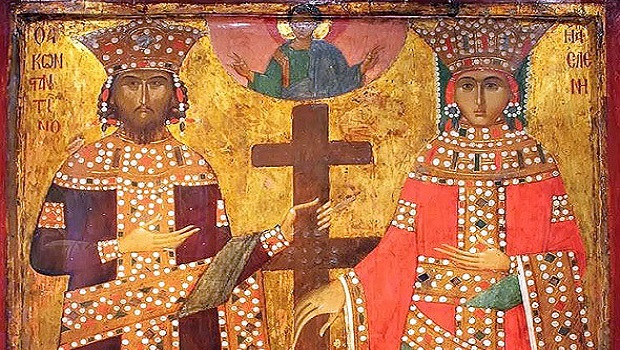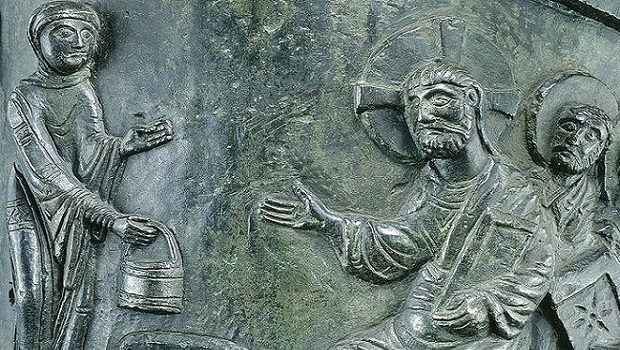Archimandrite Daniel G. Aerakis
The Resurrection continues. This is shown by the feast of the Rendition of Easter. The same messages from the night of the Resurrection are also heard at the Rendition of Easter, which is celebrated one day before the Feast of the Ascension.
Every great feast in Orthodoxy has its ‘rendition’. Every feast is a living event which is repeated in the life of the Church and in the life of the faithful.
But the re-celebration of the feast, its rendition, also takes place for another reason: so that we can again enjoy its beauty.
When a spectacle’s enjoyable, we want to see it again. When a meal’s tasty, we want to have it again. The celebration of an event in the life of Christ or the Mother of God brings sweetness to the soul, which wants to repeat the experience.
The event that brings more sweetness than any other is certainly Easter. It’s the feast of joy, the ‘feast of feasts’. The soul never leaps for joy so much as on Easter night. We rejoice over the triumph of the Lord’s Resurrection.
It’s the triumph of life over death. Of Christ over Hell. Joy over sorrow. Truth over falsehood. This jubilation over Christ’s Resurrection is universal and eternal. Heaven and earth dance together. Not once. Always, eternally. ‘It is proper that the heavens should rejoice and the earth be glad. That the whole world, visible and invisible, should celebrate. For Christ has risen, everlasting joy’ (Easter canon).
The Resurrection continues. Every time we celebrate the Divine Liturgy. The Divine Liturgy brings all the events of Christ’s life back to life before our eyes. ‘We progress through all the ages of Christ’, as Saint Gregory the Theologian says.
Christ is born at the prothesis, the preparation, which is performed in the left apse of the sanctuary and is like the manger. Christ goes out into the world to preach His Gospel at the Small Entrance, when the priest emerges holding the Gospel book aloft. Christ goes up to Jerusalem to be sacrificed at the Great Entrance. Christ is hung on the Cross and sacrificed at the offertory and at the sanctification of the Precious Gifts, which begins with the exclamation: ‘Yours of Your own’. Christ arises at the communion of the spotless Sacraments, which inundates the heart with the joy of the Resurrection. This is why, after he has made his communion, the celebrant immediately says: ‘Having seen the Resurrection of Christ…’
Every Divine Liturgy is a reminder of the Cross and the Resurrection. It’s the Passover of the Cross and the Resurrection. The liturgy on a Sunday, in particular, has a festal nature. It’s the liturgy of ‘the first day of the week’. On Sundays, everything is related to the Resurrection. The dismissal hymns in the eight tones are all about the Resurrection. So are the hymns at Mattins on a Sunday. Most of all, the period between Easter and Pentecost, which begins on Easter night and ends with the Sunday of All Saints, is particularly imbued with the Resurrection.
The Resurrection continues. It’s repeated every time the faithful celebrate Easter. Secular-minded folk have Easter once a year, and even then don’t really understand it. They don’t enjoy it. They think of Easter as the lamb on a spit, the red eggs, the partying and carousing. The faithful celebrate the real Easter, and, indeed, many times over in the course of their lives. When they experience Christ’s sacrament, the sacrament of the Cross and Resurrection, they live a new Easter. Whenever they manage to make great strides. Easter is Pesach, the Passover, a crossing over. Christ was crucified and rose in order to bring us out of the age of sin and to vindicate us. To bring us out of the works of darkness and to sanctify us. Out of mortality and into immortality.
Every time we overcome earthly matters, that we surmount an obstacle, that we conquer sorrows, that we cross the foaming river of life or survive the storm of the sea of temptations, we’re passing over most wonderfully. We’re celebrating Easter, the Passover. When we’re able to partake of the Body and Blood of Jesus Christ. With the Divine Liturgy, we not only cross but transcend. We surpass ourselves. We take on divine dimensions. We break away from the earth. We unstick ourselves from the mud. We rise up to the heavens. We become sharers in Christ. Sharers in His sufferings and in His Resurrection. We share in the divine nature (II Peter, 1, 4). We become God-bearers, Christ-bearers.
The Resurrection continues. It’s repeated in the lives of the saints. The saints are sinners who’ve been resurrected. In one hymn we entreat: ‘Raise us who have fallen into sin’. Sin is death. Repentance is resurrection. Sin is the dark night, the life of repentance the bright day. Every Christian who repents has been resurrected. Every saint is the living proof of the power of the Resurrection. Their bright lives are shafts of the light of the Resurrection.
In his homily ‘On Holy Easter’, in reference to the neophyte Christians, that is those who had just been baptized en masse on the night of Great Saturday, Saint John Chrysostom says: ‘I would like to address those who, on this light-drenched day, have been given holy baptism. These neophytes are the good offshoots of the Church, the spiritual flowers, Christ’s new soldiers. Before yesterday, our Lord was on the Cross. They, too, before yesterday were under the dominion of sin. Now they’ve been raised with Christ Who rose. Christ died in the body and then rose. They were like corpses in the pit of sin. And they were raised from sin. The earth has opened and given us roses, jasmine and other flowers. Baptism with blessed water has, today, given us the most beautiful flower garden in the world’.
The change in people is the most convincing proof of the Resurrection. People are raised up from the grave of sin through the power of repentance.
What is more difficult? For a sinner to be raised from the tomb of depravity or for a person’s body to be raised from the grave of mortality? It would appear to be the second. And yet it’s the first. There’s no resistance to the resurrection of bodies. Any change in the soul meets with resistance of the will, of the old personality.
Spiritual resurrection is extremely difficult. The irascible have to become meek; the greedy gamblers, charitable; the drunkards, restrained; the lovers of the flesh, controlled; the criminals, peaceful; and the brutal, saints. We see this in the realm of grace, in the life of the Church.
The Church has the power to transfigure, to change people. It’s the Church of the Resurrection. Christ, the head of the Church is not only He Who rose from the dead, but also He Who raises the dead. So, if the more difficult thing has been accomplished- the resurrection of so many sinners- why shouldn’t the easier thing be, too- the resurrection of the bodies at the general Resurrection?
Source: pemptousia.com




0 Comments